Australia’s Water Reform, with especial reference to the Murray Darling Basin
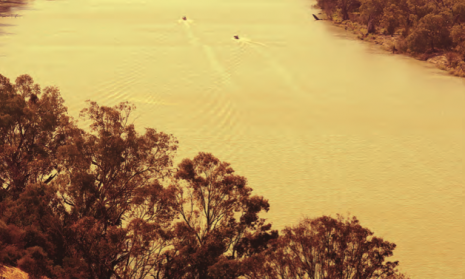
Summary
Australia initiated a water reform process in 1994 with the agreement between the Commonwealth and States/Territories governments followed by the Intergovernmental Agreement on the National Water Initiative, in 2004.
The rights for water have been separated from land titles and are separately tradable instruments, so that both permanent water access and temporary water allocations can be traded.
Water resource management has been separated from provision of water supply services. Water trading during the later stages of Australia’s “Millenium drought” (2002- 2010) showed that trading had brought significant economic benefits.
However, in developing a new Plan for the man- agement of water within the Murray Darling Basin, the principal agricultural irrigation basin in
Australia, it is proving difficult to identify an appropriate balance between water for irrigated agriculture and water for the environment while maintaining a base river flow. The sought objective is to ensure that the Basin’s rivers are maintained as “healthy working rivers”.
Keywords: Water resources, irrigation, climate change, water entitlement, water allocation, water trad- ing, groundwater, wetlands.
Glossary
base flow: the longer-term discharge derived from natural storages, often assumed to be groundwater discharge from shallow unconfined aquifers.
Basin States: Those states and territories of Australia within which parts of the Murray Darling Basin are located, viz New South Wales, Victoria, South Australia, Queensland and Australian Capital Territory.
Commonwealth Environmental Water Holder: A statutory position responsible for the management of the Commonwealth Government’s portfolio of water assets (water entitlements) and the accumulated annual yield of water (allocations) against those entitlements.
Commonwealth of Australia: The Australian government, established by the federation of the six former Australian colonies from January 1, 1901 under the Commonwealth of Australia Constitution Act 1900 (Imp), an Act of the Parliament of the United Kingdom. The current six states and two territories have their own legislatures, the division of powers between the Australian government and the states and territories having been determined by the Australian constitution.
Council of Australian Governments: A council comprising the Prime Minister as chair, the Premiers of the states, the Chief Ministers of the territories and one representative of the Australian Local Government Association.
dryland: Agricultural lands on which crops and pastures are grown dependant on natural rainfall without recourse to irrigation.
National Water Commission: A statutory authority established under the National Water Commission Act 2004 (Cwlth) to advise CoAG and the Australian Government on national water issues and the progress of the National Water Initiative.
Prescription: A process introduced under legislation when the level of water use in an area indicates that regulatory control is needed to secure sustainable management and to support water dependent ecosystems.
Standing Council on Environment and Water: A council of Ministers established following the 2010 review of the ministerial council system. It considers matters of national significance on environment and water issues. The Standing Council on Environment and Water comprises Commonwealth, state, territory and the New Zealand environment and water ministers and the Australian Local Government Association. It meets approximately six monthly, replacing the previous Natural Resource Management Ministerial Council and the Environment Protection and Heritage Council.
Water access entitlement: A perpetual, or ongoing, entitlement to exclusive access to a share of water from a specified consumptive pool, as defined in the relevant water plan accredited by the appropriate level of government. It constitutes a tradable property right.
Water allocation: The specific volume of water allocated to a water access entitlement in a given season, calculated from, and often expressed as, a percentage of the full water entitlement.
Water bore: a bore, well or excava- tion, usually constructed by a licensed bore or well driller, used for the purpose of inspection, interception, collection, storage or extraction of groundwater.
Water entitlement reliability: the frequency with which water allocated under a water access entitlement is able to be supplied in full. (Queensland, New South Wales, Victoria and Tasmania each have a system for defining higher and lower reliability water products.)
Abbreviations ACCC Australian Competition and Consumer Commission; ACT Australian Capital Territory; AUD Australian dollars; BoM Bureau of Meteorology; CEWH Commonwealth Environmental Water Holder; CoAG Council of Australian Governments; CSIRO Commonwealth Scientific and Industrial Research Organisation; DSEWPaC Commonwealth Department of Sustainability, Environment, Water, Population and Communities; GL gigalitre (109 litres); IIO irrigation infrastructure operator; MDB Murray Darling Basin; MDB IGA Murray Darling Basin Intergovernmental Agreement; MDBA Murray Darling Basin Authority; MDBC Murray Darling Basin Commission; NSW New South Wales; NT Northern Territory; NWI Intergovernmental Agreement on a National Water Initiative; SA South Australia; SCEW Standing Council on Environment and Water; WA Western Australia.
Introduction
Australia is a geologically old, relatively flat, continent with extensive areas of desert and semi-desert. There is high rainfall variability within and between seasons and a high evaporation rate, with a risk of droughts and floods.
It presents a microcosm of global water governance issues as its states face the same jurisdictional difficulties as sovereign nations sharing water resources, because responsibility for water resources is a matter for state governments, not the Australian (Commonwealth) government.
Management of water resources was retained by the states at the time of establishing the Commonwealth of Australia in 1901, under clause 100 of the constitution (1).
The distribution of rainfall is shown in Figure 1. The principal areas of precipitation are the eastern coast, where the majority of the population resides, and in the sub-tropical latitudes across sparsely settled northern Australia. Rainfall is uneven.
On average, only 12% of rainfall runs off to collect in rivers: in five of Australia's 12 drainage divisions, run- off is less than 2%; in the two drainage divisions of tropical monsoonal divisions of Timor Sea and Gulf of Carpentaria, run-off is greater than 20%.
The remaining 88% of rainfall is accounted for by evaporation, water used by vegetation; and water held in storages including natural lakes, wetlands and groundwater aquifers (Figure 1) (2).
The principal surface water basin used for irrigated agriculture is the Murray Darling Basin (MDB), shown in Figure 2. Approximately 6 % of its rainfall runs off and about 51% of that is used for consumptive purposes for industry, irrigation and stock and domestic use (4).
The Murray and Darling rivers and their tributaries have highly variable flows. Over the past 100 years, the Basin’s agricultural base has been transformed from a low intensity, volatile dry land to a more intensive, mixed irrigation and dryland system.
The Murray-Darling Basin generates 39% of Australia’s agricultural produc- tion by value and approximately 40% is irrigated (15% of national agricultur- al output).
Production of agricultural commodities now represents 93.7% of land use across the Basin, 32% of businesses and 10.8% of national employment (Figure 2) (5).
Australia’s highly variable rainfall makes it difficult to determine any specific local response to global warming, but there is evidence of the potential impact of possible climate change in recent rainfall trends.
Figure 3 shows a decline in mean annual rainfall expressed in ten year increments for the period 1970 to 2010 over much of eastern Australia and south-west Western Australia (6).
This decline in rainfall affected urban water catchments and household water consumption of all capital cities except Darwin, as well as affecting production agriculture (Figure 3).
The Southern Oscillation index, leading to drought when in the El Nino phase and to floods in the La Nina phase, has attracted much attention. From 2002 to 2009, southern Australia was subjected to the “Millenium drought”, while during the La Nina condition of 2011-12, high rainfall and floods were widely experienced in southern and eastern Australia.
These events have focussed the minds of water policy makers. Irrigation water rights and water resource management have emerged as major policy issues for governments in the past twenty years.
The commencement of irrigation schemes
Formal irrigation commenced on the River Murray, Australia’s principal river, at Renmark and Mildura in 1887, using technologies imported from California.
It was recognised within Australia from the late nineteenth century that water resources were limited and varied widely between seasons, so a policy of sharing available water proportionately has long been adopted (7).
Various irrigation schemes were established after World War I and World War II for the settlement of discharged ex-servicemen, who aspired to farming although inevitably as production efficiency has improved, these holdings became inadequate in size.
Some water resource management units, either for surface water or ground water, were prescribed and entitlements defined, though the potential for interconnection between surface and groundwater went largely unnoticed.
In many other areas, access to water was governed by traditional riparian rights. Dams were built in other locations by governments, usually on a basis of encouraging “nation building, closer settlement and economic development”, often as a result of electoral commitments rather than any direct benefit: cost appraisal.
Regulating the River Murray
After the severe 1914-15 drought and following 13 years of negotiation, the Commonwealth, NSW, Victoria and South Australia developed the Murray Waters Agreement.
This led to the creation of the River Murray Commission in 1915, to manage and regulate the volumes of water in the system. Plans were agreed to ensure reliable and economical river transport (almost immediately rendered redundant by advances in railways and motor transport) and to share the water.
The plans were to construct a major storage on the Upper Murray, to build Lake Victoria to control flows to South Australia, to construct 26 weirs and locks between Echuca and Blanchetown on the River Murray, (only locks 1-11, 15 and 26 were built), and to construct others on the Murrumbidgee or Darling rivers.
The plans would also coordinate the construction of water storages and locks to regulate the rivers.
The states within the Murray Darling Basin took different approaches to irrigation water, depending upon water availability and seasonal conditions.
Two classes of water reliability have evolved in New South Wales and Victoria. A high-reliability entitlement may receive a 100% water allocation against its unit share during all but the most severe droughts.
High-reliability entitlements are allocated water first, before any water is allocated to entitlements belonging to a lower reliability category.
New South Wales has a small proportion of irrigation water with “higher reliability” which is more suitable for perennial plantings such as horticultural tree crops, grapes and perennial pastures for dairy and beef production and a large proportion of “lower reliability” irrigation water which is primarily used for growing annual crops (cereals, rice, and cot- ton).
Victoria has a greater proportion of high reliability water which has encouraged dairying in that state. All South Australia’s irrigation water is at the same level of reliability and is predominantly used for perennial crops.
Queensland irrigators operate on unregulated rivers and are permitted to capture water into their own holding tanks and dams according to rules that apply during periods of high flow.
The distribution of these arrangements is illustrated in figure 4. Water for essential human needs in the main cities and towns is provided by state or local government owned water agencies.
A restructured Murray Darling Basin Commission
During the 1980s, it was recognised that water quality needed to be managed and its importance in maintaining biodiversity and ecosystem services was recognised.
Most states had established environment protection authorities. In the late 1980s, the management of the Murray Darling Basin was restructured by the establishment of a new Murray Darling Basin Commission whose responsibilities extended to encompass water, land and the environment. Ministers from all of these portfolio areas participated in a Ministerial Council chaired by the Commonwealth.
Strategies were developed for managing aspects of water quality in the Basin. A salinity strategy recognised the natural entry of saline groundwater into the river as well as salinity deriving from excessive irrigation which leached salts into the river.
Although a subsidy on phosphate use had been removed in 1973, there was increasing use of nitrogen fertilisers which led to non-point pollution and periodic algal blooms. A series of salt interception bores (wells) was established adjacent to the river in downstream South Australia and saline groundwater was pumped to sacrificial evaporation basins, partly to offset increasing upstream salinity.
In addition, by coordinating releases of water from various dams and reservoirs, a water quality standard of less than 800 electro-conductivity (EC) units expressed as μS/cm (microsiemens per centimetre) at Morgan, South Australia, was to be achieved 95% of the time. This integrated approach to salinity manage- ment has generally been successful.
At the same time, irrigators were being encouraged to adopt “improved irrigation practices”. Most irrigation had involved flood systems using siphons from irrigation channels.
Growers began to laser level the bays in which flood irrigation water was applied to ensure an even advance of the irrigation front, and relatively even applications of water across the irrigation landscape.
Return of excess irrigation water (“tail water”) became prohibited. Meanwhile, large overhead sprinklers, which rarely supplied water evenly, were being replaced by under- tree microsprinklers or drip systems.
Sub-surface drippers were also introduced in some cropping systems such as for cotton, though their high installation cost, constraints on row spacing of subsequent crops and difficulties of maintenance, especially where chewed by mice, have limited their adoption.
The initiation and development of Water Reform policies
The Council of Australian Governments (CoAG), agreed in 1992 to establish a National Competition Policy and commissioned an Independent Committee of Inquiry (9) which led to a programme of economic reforms.
In 1994, CoAG agreed to a range of water resource policy proposals to arrest widespread natural resource degradation occasioned, in part, by water use. A package of measures, known as the 1994 Water Reform Agenda (10), was adopted to address the economic, environmental and social implications of future water reform.
States were to give priority to formally determining entitlements and allocations to water, including for the environment.
Among other major aspects were the principles of consumption-based pricing, full-cost recovery and desirably of the removal of cross-subsidies, to be achieved for rural water supplies by 2001; establishment of comprehensive systems of water entitlements and allocations, backed by separation of water property rights from land title and the clear specification of entitlements in terms of ownership, volume, reliability, transferability and, if appropriate, quality.
Environmental requirements, wherever possible, would be determined on the best scientific information available to maintain the health and viability of river systems and groundwater basins. In cases where river systems were perceived to be over-allocated for consumptive use, arrangements were to be instituted by 1998 to provide a better balance in water resource use, including appropriate water to restore the health of river systems.
The roles of water resource management, standard setting, regulatory enforcement and service provision were to be separated so that water delivery organisations would have a commercial focus.
Water policy issues were then addressed nationally through six-monthly meetings of the Ministers responsible for water resources from the six state governments and two territories, along with the responsible Australian (Commonwealth) government Minister who chaired the meetings of what is now called the Standing Council for Environment and Water (SCEW).
Policy papers and proposals are prepared for the Ministerial Council by a committee of officers, which earlier had included members from the CSIRO and the Bureau of Meteorology, but that is now restricted to individuals from the respective water resources departments of the Commonwealth, states and territories.
Subordinate bodies and working par- ties are commissioned to address specific issues, for example the development of guideline documents within the National Water Quality Management Strategy that encompass topics such as the Australian Drinking Water Guidelines, National Guidelines for Water Recycling – Managing Health and Environmental Risks, and Australian Guidelines for Water Recycling: Managing Health and Environmental Risks (Phase 2): Augmentation of Drinking Water Supplies (11).
The National Water Initiative (NWI)
From 2004, the Commonwealth and all states and territories signed a 108 clause non-statutory Intergovernmental Agreement on the NWI.
The agreement (12) encompasses implementation clauses on water entitlements, water markets and trading, water pricing, management of environ- mental water, water accounting, urban water, community partnerships, and knowledge and skills.
The National Water Commission was established in March 2005 to assist with the effective implementation of this Agreement, and has undertaken biennial assessments of progress.
The NWI confirmed the rights to surface and groundwater sources being separated from the ownership of land, each having a separate title.
The water asset is defined as a water access enti- tlement, being a perpetual, or ongoing, entitlement to exclusive access to a share of water from a specified consumptive pool as defined in the relevant water plan, accredited by the appropriate government. (The entitlement share in the consumptive pool can be compared with an equity shareholding in a stock-exchange listed company.)
The entitlement may be expressed as a volume at 100% allocation. The consumptive pool is the amount of water resource that can be made available for consumptive use in a given water sys- tem (catchment and/or groundwater basin), while ensuring sustainable protection of the natural environment.
The water allocation is the specific volume of water allocated to a water access entitlement in a given season, defined according to rules established in the relevant water plan. The allocation reflects the seasonal availability of water in that year to be shared in proportion to holders’ entitlements within a catchment or groundwater management unit.
This means that in a drought year, all owners of entitlements within a state or territory share the same proportionate reduction in water volume. Irrigators may have some ability to carry over their allocation of water from one season to another if storage capacity is available.
In an irrigation system, a delivery share is a share of capacity in an irrigation supply channel, or a water course, and may limit the rate at which a water allocation can be accessed.
A water use licence defines the purposes for which the water can be used. Entitlements available in Australia, by state, are shown in Table 1 (8).
Although the Intergovernmental Agreement on the National Water Initiative defined the terms for “entitlement” and “allocation”, the current legislation within the states and territories still uses a variety of terms rather than the agreed NWI-compliant terminology.
This can make trading across jurisdictional borders difficult to understand. The range of terms in use in 2011 is shown in Table 2.
Water Trading
Water entitlements and allocations, as well as being held by water supply service providers and private owners (usually irrigators or industrial users), can also be provided to environmental managers.
Since access to water has become a recognised property right and water is tradeable, governments have established titles registers for water rights and include on the water title any encumbrances, such as a mortgage, over the water resource.
The water titles recognised historical legal access to water and in essence, the original recipient of a title to an existing resource has generally received a “free good” which has acquired a capital value.
This may be at the expense of the capital value of the owner’s land which no longer auto- matically commands access to water.
Where an irrigation infrastructure operator (IIO) holds a bulk water entitlement, the water market rules prohibit actions of an IIO that prevent, or unreasonably delay, irrigators from transforming all or part of their irrigation rights into separate statutory water access entitlements, allowing them to be traded outside the irrigation district if they wish to do so.
“Unallocated” water is vested in the State governments. Where there is unallocated water available, access may be granted by the state on a basis of competitive bids.
Owners of water have the option of selling or leasing some or all of their water allocation in any given season for “temporary transfer” to a buyer at a mutually negotiated price.
Trading across state borders has been possible since 2006. Alternatively, the owner of the water can sell the entitlement out- right (a “permanent transfer”), in which case his land no longer has access to irrigation water.
Market experience during the drought suggested that the price of a “permanent” sale was roughly five to ten times that of a “temporary” sale of one season’s water.
Water brokers facilitate water trades in a comparable manner to stock brokers facilitating trade in equities.
These arrangements have encouraged the transfer of water to its highest value uses. For example, during the drought, rice growers found it more profitable to sell their water allocation rather than grow a rice crop. This is illustrated in Figure 5.
It has been estimated that water trading in the southern Murray-Darling Basin added 220 million AUDollars to Australia's GDP in 2008-09; with net production benefits of AUD 79 million in New South Wales, AUD 16 million in South Australia and AUD 271 million in Victoria (13).
The extent of allocation trading that can occur is shown in Figure 6 for the Southern Murray Darling Basin in 2008-9, which was towards the end of the Millenium drought.
The prices of water entitlement (“permanent”) trading are much less volatile than water allocation (“tempo- rary”) trading. This is to be expected, given the long-term nature of the investment that is made in an entitlement purchase.
The Australian Government has been active in the water market since 2008 through its purchases of entitlements for environmental purposes under the Restoring the Balance in the Murray–Darling Basin programme.
Across the entire MDB, the volume of trade registered as Commonwealth environmental water purchases increased from zero in 2007–08 to a cumulative total of 1 173 GL by November 2011.
The water markets outside the MDB remain relatively small, with a lower level of trading than those within the Basin. In some areas, there is not yet significant scarcity of water resources.
Rights to unallocated water may still be issued. In other areas, the level of irrigated agricultural development may not be sufficient to support a water market.
There is less connectivity, both naturally and engineered, between water systems outside the MDB and market mechanisms such as registers, trading platforms, trade processing systems may not be extant.
Market information may be much less readily available. However, entitlement trading outside the MDB increased to 205 GL in 2010–11 from 131 GL in 2009–10.
Increases in entitlement trading occurred in all states except Tasmania, although the increase in trading in Victoria was primarily a result of the inclusion of groundwater entitlement for the first time in 2010–11 (contributing about 27 GL to the Victorian total).
The Potential Impact of Climate Change
The Millenium drought focussed minds on the potential for climate change. The then Prime Minister and Basin States Premiers commissioned CSIRO in 2008 to report on sustainable yields of surface and groundwater systems within the MDB.
The report from the Murray-Darling Basin Sustainable Yields Project (15), summarised the assessments for 18 regions that comprise the Basin. Project results were framed around four scenarios of climate and development defined by 111 years of daily climate data.
The baseline scenario was the historical climate from mid-1895 to mid-2006 and the current level of water resource development.
The second scenario was based on the climate of 1997 to 2006, to evaluate the consequences of a long-term continuation of the Millenium drought in south eastern Australia.
The third scenario considered cli- mate change to 2030 using three global warming levels and 15 of the global climate models included in the fourth assessment report of the Intergovernmental Panel on Climate Change (16).
The fourth scenario considered likely future development and the 2030 climate. Development includ- ed growth in farm dam capacity, expansion of commercial forestry plantations and increases in groundwater extraction.
The 18 regions are shown in Figure 7 and the impact of potential climate change in Figure 8. Although a high variability in the estimates was recognised, it was concluded that the greatest impacts of climate change arising from global warming were likely to be felt in the southern and south-western areas of the Basin.
The Basin Plan
Various intergovernmental agreements have operated in the Murray Darling Basin (MDB) since 1915. A new Murray Darling Basin Agreement was given full legal status by the Murray-Darling Basin Act 1993 (Cwth).
This agreement created new institutions to underpin its implementation, including the Murray Darling Basin Ministerial Council and the Murray Darling Basin Commission (MDBC). After the signing of the NWI, the MDB continued to experience significant stress from the combined impacts of over allocation of water, severe drought and what were perceived as the early impacts of climate change.
There was a marked decline in river health and it was considered necessary to take additional action to return the system to a sustainable footing. The Water Act 2007 (Cwth) was proclaimed to assist implementation of the NWI within the MDB.
The Commonwealth gained additional responsibilities for water reform following the signing of the Intergovernmental Agreement on Murray Darling Basin Reform (MDB IGA) (17) in July 2008 by the Commonwealth, New South Wales, Victoria, Queensland, South Australia and the Australian Capital Territory (the Basin States).
The Commonwealth agreed to provide assistance to undertake water projects in the MDB, subject to the achievement of agreed outcomes, effectively subsidising infrastructure improvements which may also reduce water losses; albeit these subsidies dilute the intention of the full-cost recovery clauses of the earlier National Water Initiative.
Nevertheless, under the MDB IGA, the Commonwealth and the Basin States reaffirmed their commitment to implementing the NWI. The Water Act 2007 (Cwlth) established two new statutory bodies, the Murray Darling Basin Authority (MDBA), which replaced the MDBC and the Commonwealth Environmental Water Holder (CEWH).
The MDBA was given responsibility for developing an enforceable Basin Plan (a high-level plan to ensure the water resources of the MDB can be managed in an inte- grated and sustainable way).
The CEWH was given responsibility for managing the Commonwealth's environmental water holdings, and protecting or restoring environmental assets in the MDB and in other areas where environmental water is held.
The Australian Competition and Consumer Commission (ACCC) was given responsibilities relating to water market and water charge rules.
The MDBA released a Guide to the proposed Basin Plan in October 2010 which also took account of potential climate change. The Guide provided an overview to assist people to understand the basis of the proposed Basin Plan, and the rationale for the proposals.
The then existing take of water for consumptive purposes was 15 400 GL per year, made up of 13 700 GL of sur- face water and 1 700 GL of groundwater. Reductions of 3 000, 3 500 and 4 000 GL per year were hypothesised. However, the Guide was widely misinterpreted as “The Plan”.
Growers assumed they would compulsorily lose water (the plan actually proposed the Commonwealth would buy water from willing sellers), and it was argued that many communities would be ruined.
Numerous meetings were held. While they were generally orderly, there was much press activity including that inducing a group of farmers to burn copies of the Guide. Pre-consultation had been inadequate, the irrigators felt threatened, interpretation of water reliability differences was unclear, and there were differing interpretations of the Water Act 2007. Actual readership and comprehension of the Guide was probably not high.
Subsequently, the incoming Chairman of the MDBA visited widely around the Basin while the Authority developed a draft Plan, which was released for consultation in November 2011. It does not take account of potential climate change.
The formal Proposed Basin Plan has the appearance of a draft Bill for Parliament – a daunting format not easily assimilated (19).
However, it was accompanied by a well presented Plain English Summary of the proposed Basin Plan, (20) which included explanatory notes. It suggested an initial reduction in the “sustainable level of take” of surface waters to 10 873 GL/year, a reduction of 2 750 GL/year.
Specific reductions were suggested in individual catchments, with additional non-specific reductions sought across all catchments to maintain base river flow, though how these figures were determined was not clearly outlined.
A review of progress and implementation mechanisms by 2015 was suggested, with achievement of imple- mentation of the plan by 2019.
A website was established to receive feedback on the Proposed Basin Plan over a five month consultation. Over 12, 000 responses had been received by the close of the consultation period, though it must be observed that a high proportion were “campaign sub- missions” sent in as “form letters”.
It now remains for the Murray Darling Basin Authority to review its Plan before presentation to the Minister for Sustainability, Environment, Water, Population and Communities who must then seek approval in the Federal parliament.
Conclusions
Central to the development of the Murray Darling Basin as the principal location of Australia’s irrigated agriculture has been the necessity for collaboration and compromise to recognise the needs of the states in the Basin, and the constitutional rights of those states to manage water resources.
As production intensity has increased and land development continued, the states identified the need to move from merely managing the volume of water in the basin to managing its quality, the impact of consumption on the environment, its biodiversity and on land use change.
Management has moved from solely a water policy approach to a landscape management approach, albeit often driven by the competitive expectations of the states for water access. Policies have evolved over time.
The apolitical adoption of an agreed set of policy principles in the 1994 Water Reform Agenda and the 2004 Intergovernmental Agreement on the National Water Initiative, along with an audit mechanism through the establishment of the National Water Commission to undertake a biennial assessment of progress in implementing the agreements has provided an underpinning for future water management.
However, the implementation of these principles at regional and land- holder level has inevitably introduced a political component into the rate of adoption of the principles.
Since the NWI is non-statutory, it is not completely binding on the signatories, and progress can depend on the extent of “rewards and sanctions” that may be available, effectively amounting to encouragement by the Commonwealth through availability of grants.
Sanctions had been available to ensure the introduction of water trading over state borders at the time of the first biennial assessment of progressing the commitments to the NWI, with payments to the states having being withheld until functional cross border trading mechanisms were in place. These sanction mechanisms are no longer available.
Implementation of different aspects has varied between the states/territories, and has fallen well behind the originally announced and ambitious timetable. As well as reviewing the general progress of implementing the NWI, the National Water Commission’s biennial assessments review progress by the individual states and territories (21).
The states have not been particularly appreciative of having to provide advice to the National Water Commission on progress they have been making.
An example of differential progress was the obligation for legislative and administrative regimes to be amended to incorporate the elements of the entitlements and allocation framework in the Agreement by the end of 2006.
Almost all jurisdictions brought in new legislation, but Western Australia continues to operate with an amended Rights in Water and Irrigation Act 1914 (WA). As of 2011, WA, in terms of NWI clause 26(ii), had not implemented NWI-compliant legislation to provide the statutory basis for water access entitlements (21).
The Commission has expressed its frustration that by 2010, the states had not made substantial progress in adjusting all over-allocated or overused water systems to sustainable levels of extraction (21). Yet the agreement is still in place, and progress is still being made, but more slowly than anticipated in 2004.
As part of that timetable, the National Water Commission was due to close on 30 June 2012, but as a result of a review (22), it will continue for the life of the NWI.
Nevertheless, the NWI principles have not become politicised. The primary benefits of these policies have been the clear definition of rights to water, the recognition of these rights as a capital asset that is separately tradable, and the ability to allow water to move to its highest value uses with economic benefits having been demonstrated.
The principle of sharing the impact of drought on water allocations among entitlement holders has been well established. It is notable that there is virtually no personal litigation industry in Australia dealing with water. The needs of the environment to maintain a base flow in rivers is increasingly being provided.
However, these policies are complex and when efforts have been made to adopt them within the competitive environment of the Basin States, their implementation can become less than objective.
Local self-interest has become a dominant component. Political and journalistic opportunism has arisen. The states have threatened litigation against each other (but as of April 2012, had yet to implement any such intentions).
The underlying implementation must be built on sound science and evidence.
The political realities in a democracy are that the stakeholders, whether water users or environmentalists, as well as the governments must accept the policy objectives, with the economic, social and environmental issues being considered together.
Australia has undertaken a pioneering water reform journey, its progress has been slower than was anticipated, yet there remains an expectation that it will ultimately be successful. The associated political difficulties can be overcome with good will and an understanding of the importance of sound research-based evidence.
The system being developed in the Murray Darling Basin could serve as a guide for other river basins where irrigation needs compete with people and the environment.
References
1) Commonwealth of Australia Constitution Act 1900 (Imp) constituting the Commonwealth of Australia, http://www.austlii.edu.au/au/legis/cth/con- sol_act/coaca430/ (accessed March 23 2010) (2) National Land and Water Resources Audit (2000) Australian Water Resources Assessment 2000, NLWRA, Canberra http://www.anra.gov.au/topics/water/pubs/na tional/water_availability.html (accessed April 23 2012)
(3) Bureau of Meteorology (2012) Average Annual Rainfall 1960-1990. http://www.bom.gov.au/jsp/ncc/climate_aver- ages/rainfall/index.jsp (accessed 23 March 2012)
(4) National Land and Water Resources Audit (2002) Australia’s Natural Resources 1997- 2002 and beyond, NLWRA, Canberra. http://www.anra.gov.au/topics/publications/fi nal-report/water.html (accessed 23 March 2012)
(5) EBC, RMCG, Marsden Jacob Associates, EconSearch, Geoff McLeod, Tim Cummins, Guy Roth and David Cornish, (2011), Community impacts of the Guide to the pro- posed Murray-Darling Basin Plan- Executive Summary. Report to the Murray-Darling Basin Authority, May 2011. http://www.mdba.gov.au/files/bp-kid/257- EBC-Vol1-exec-summary.pdf (accessed 18 March 2011)
(6) DSEWPaC (2011) State of Environment 2011 – 3. Climate http://www.environment.gov.au/soe/2011/rep ort/atmosphere/2-1-current-state-climate.html (accessed 13 April 2012)
(7) Haisman, B. (2005) Impacts of Water Rights Reform in Australia. In Water Rights Reform: Lessons for Institutional Design (Ed Burns, R., Ringler, C. and Meinzen-Dick, R) IPFRI, Washington, DC, USA
(8) National Water Commission (2010) Australian Water Markets Report 2009–10, National Water Commission, Canberra http://nwc.gov.au/publications/topic/mar- kets/water-markets-report-december-2010 (accessed 23 March 2012)
(9) Hilmer, FD, Rayner, MR and Taperell, GQ (1993). National Competition Policy, (Australian Government : Canberra) 373pp. http://ncp.ncc.gov.au/docs/HilEx-001.pdf (accessed 18 March 2012)
(10) CoAG (1994). Attachment A - Water Resource Policy, Council of Australian Governments' Communiqué, 25 February 1994, http://www.coag.gov.au/coag_meet- ing_outcomes/1994-02- 25/docs/attachment_a.cfm (accessed 18 March 2012)
(11) Department of Sustainability, Environment, Water Population and Communities (2011). National Water Quality Management Strategy. http://www.environ- ment.gov.au/water/policy- programs/nwqms/#guidelines (accessed 23 March 2012)
(12) CoAG (2004) Intergovernmental Agreement on the National Water Initiative http://www.coag.gov.au/coag_meeting_out- comes/2004-06-25/index.cfm#nwi (accessed 23 March 2012). (13) NWC (2011) Australian water markets: trends and drivers 2007–08 to 2010–11. National Water Commission:Canberra, 87pp, http://www.nwc.gov.au/__data/assets/pdf_file/ 0005/18986/NWC_6959-Trends-and- drivers.pdf (accessed 18 March 2012) (14) NWC (2010). The impacts of water trading in the southern Murray–Darling Basin: an economic, social and environmental assessment. National Water Commission, Canberra http://www.nwc.gov.au/__data/assets/pdf_file/ 0019/10783/681- NWC_ImpactsofTrade_web.pdf (15) CSIRO (2008) Water availability in the Murray–Darling Basin: a report to the Australian Government from the CSIRO Murray–Darling Basin Sustainable Yields Project, CSIRO : Canberra. http://www.clw.csiro.au/publications/water-forahealthycountry/mdbsy/pdf/WaterAvailabilit yInTheMDB-FinalReport.pdf (accessed 22 March 2012) (16) IPCC (2007) Climate Change 2007: The Physical Basis. Contributions of Working Group 1 to the Fourth Assessment Report of the Intergovernmental Panel on Climate Change. Cambridge University Press, Cambridge. http://www.ipcc.ch/publications_and_data/publications_ipcc_fourth_asses sment_report_wg1_report_the_physical_sci- ence_basis.htm (accessed 25 April 2012)
(17) CoAG (2008) Intergovernmental Agreement on Murray-Darling Basin Reform http://www.coag.gov.au/coag_meeting_out- comes/2008-07- 03/docs/Murray_Darling_IGA.pdf (accessed 23 March 2012) (18) MDBA (2010) Guide to the Murray Darling Basin Plan MDBA, Canberra http://download.mdba.gov.au/Guide_to_the_ Basin_Plan_Volume_1_web.pdf (accessed 25 March 2012) (19) MDBA (2011) The Proposed Basin Plan MDBA, Canberra http://download.mdba.gov.au/proposed/pro- posed_basin_plan.pdf (accessed 25 March 2012) (20) MDBA (2012) Plain English Summary of the proposed Basin Plan MDBA, Canberra. http://download.mdba.gov.au/proposed/plain _english_summary.pdf (accessed 25 March 2012) (21) NWC (2011). The National Water Initiative - securing Australia's water future: 2011 assessment National Water Commission, Canberra http://www.nwc.gov.au/reform/assessing/bien nial/the-national-water-initiative-securing-aus- tralias-water-future-2011-assessment (accessed 25 March 2012) (22) Rosalky, D (2012). COAG Review of the National Water Commission, (DSEWPaC, Canberra) http://www.environment.gov.au/water/aus- tralia/nwi/pubs/coag-review-national-water- commission.pdf (accessed 16 April 1012)
Download pdf
Figures
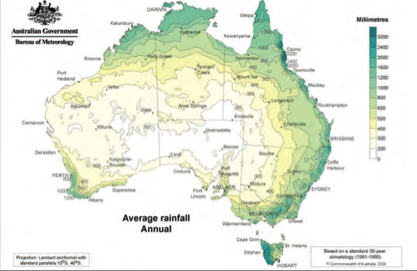
Figure 1: Distribution of Average Annual Rainfall, Australia 1961-1990 (2)
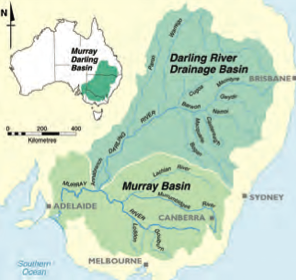
Figure 2: The Murray Darling Basin (CSIRO).
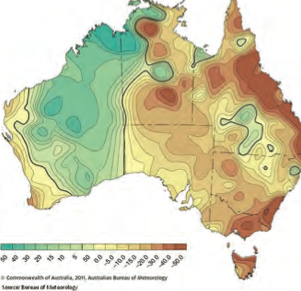
Figure 3: Trend in annual rainfall (millimetres per ten years) between 1970 and 2010 (5).
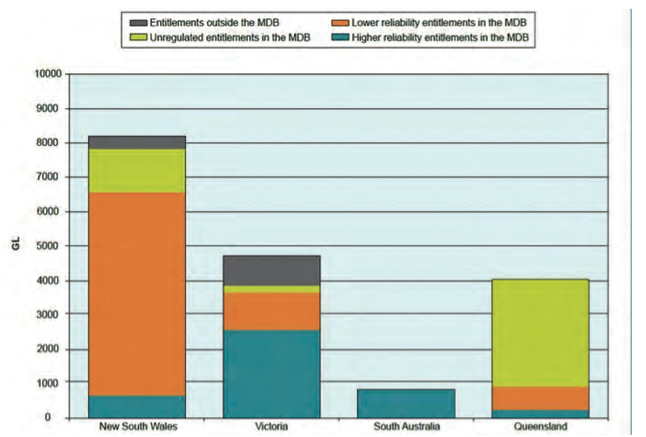
Figure 4: Classes of water entitlements in the Basin States, expressed in GL (109 litres) at 100% allocation (8).
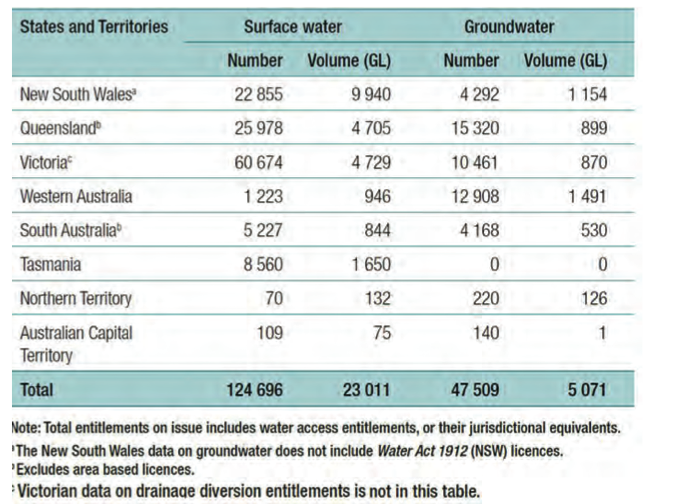
Table 1: Water entitlements issued by states, 2010 and the total enti- tlement volume expressed in gigalitres (GL, 109 litres) on issue in each state at 100% allocation (8)
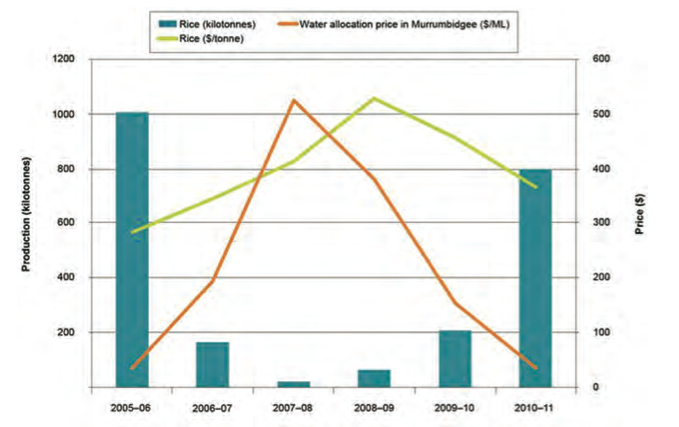
Figure 5: Rice production (kilotonnes), rice prices (AUDollars per tonne) and water allocation prices (AUDollars per Megalitre), 2005-6 to 2010-11 (13).
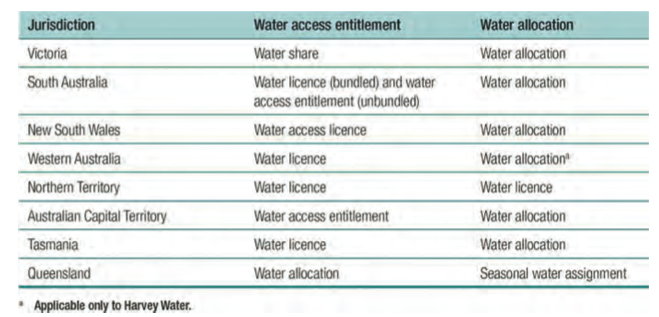
Table 2: National Water Initiative – equivalent terminology, 30 June 2011 (13)
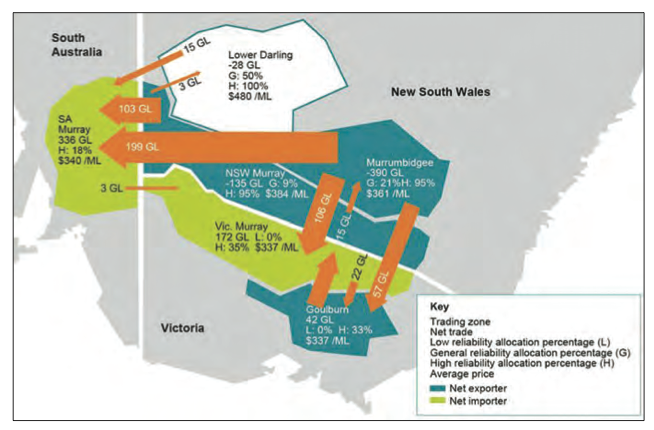
Figure 6: Interzone water trading in the Southern Murray Darling Basin, 2008-9 (13)
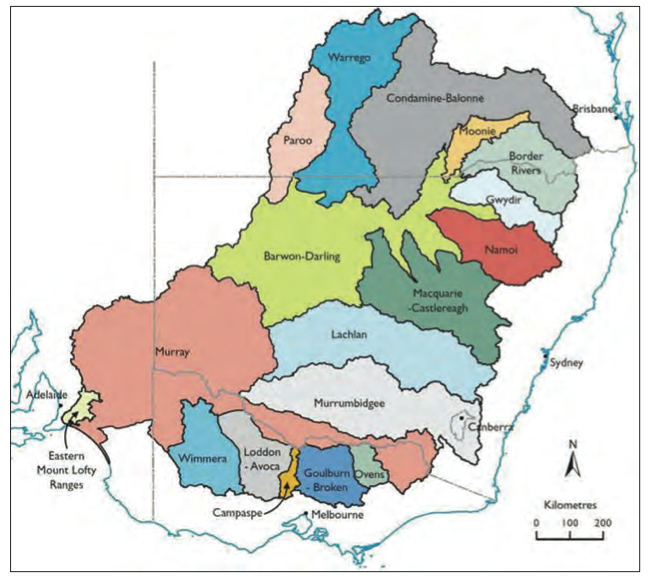
Figure 7: The 18 regions adopted for the Murray Sustainable Yields Study, based on the major tributaries of the MDB, reflecting existing river system models and surface water sharing plan areas (15).
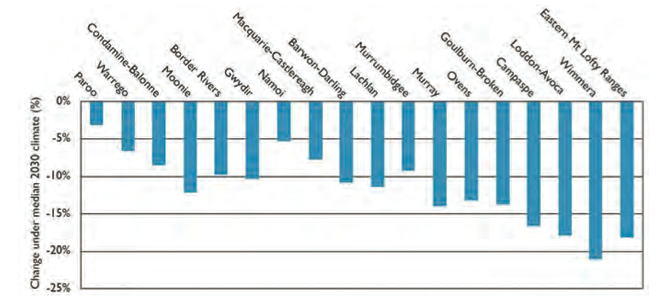
Figure 8: The percentage changes in average surface water availability by Murray Darling Basin region under the median 2030 climate model (15).

